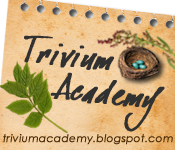I received this in Circe's e-newsletter, which can be subscribed to at http://www.circeinstitute.org/
Lessons from a Fairy Tale
by Erin Linton (Guest Writer)
Fairy tales are an invaluable resource for our children - even beyond the enjoyment, heritage, cultural literacy and examples of superb writing and story telling they provide. Without posing the difficulties of analyzing Tolstoy or Augustine, fairy tales like those written by the Brothers Grimm, Hans Christian Anderson and Margery Williams deal with literary technique and questions of life in a simple and instructive way. Margery Williams’ The Velveteen Rabbit is such a fairy tale.
Fairy tales are able to create categories that enable children to make moral judgments about people and situations, and then to assess where they themselves fit into the story. Margery Williams divides those who can become real and those who cannot. The arrogant, modern, plastic toys in The Velveteen Rabbit cannot become real even though they try their hardest to imitate reality with their gears, cranks, and beeps. The soft, forgiving toys, however, such as the rabbit and the Skin horse, can become real. The child is presented with the question, “Who are you more like?”
These fairy stories also raise and answer some of our deepest existential and theological questions. What does it mean to be real? The velveteen rabbit desperately wants to be real, but he does not know exactly what "real" is or how to “become real.” Williams resolves this by saying that it is a long and physically wearing process through the continuing love of and service to the master. The rabbit is loved by the little boy and is eventually called “real” after playing in the garden. He then later serves the boy amidst scarlet fever, bringing about a second “reality.” All of a sudden, the doctrines of justification and sanctification are not so difficult for a ten year old to understand.
While learning to judge the world around them, children also learn how to correctly judge and understand good literature by reading fairy tales. Literary techniques like symbolism, metaphor, allusion, the pathetic fallacy, etc., are vital to fairy tales. A reader of fairy tales must broaden his mind beyond the merely literal to grasp the depths of these stories, which prepares him to read every type of literature. The symbolism of names, for example, is evident in The Velveteen Rabbit; the only two creatures who understand reality are the rabbit, filled with “dust,” and the “Skin” horse, symbolizing that it is mankind who is meant to be real. There is also important symbolism wrapped in times and seasons. In this story, new life comes at Christmas, in the Spring, or in the morning; sickness and death come in autumn or at night.
Even more striking are the literary symbols of water, garden, and darkness. Water is almost always a literary metaphor for cleansing or baptism. It is no surprise then that the velveteen rabbit is left outside to be drenched with dew right before he is “christened” by the boy with the name “real.” It is also fitting that this baptism scene takes place in the garden, a common picture of the church, the new Eden . After the rabbit has received this first reality in his baptism, he lives by faith that he is real, but knows that he is not complete. There are bunnies still more real than he is. After faithfully serving his master, the rabbit symbolically dies. On an autumn night, the unclean rabbit is placed outside the camp/house among the rubbish. There the rabbit dies and is eventually raised and given his second reality by the magic of the nursery fairy. An understanding of these symbols is vital to the understanding of the deeper meaning in Margery Williams’ story, just as it is in all literature.
A last noted benefit of fairy tales is that, unlike “realistic” stories that strip all unnecessary fantasy from the mundane aspects of life, fairy tales strip away the mundane to show us the fantastical, which is usually the most simple and realistic view of the world. From man’s perspective, what else is history but the fantastical transformation of the harlot of Israel into a virgin church bride? What, other than magic, could raise the dead? It’s the same sort of magic that turns a puppet into a real boy, and turns a stuffed bunny with no hind legs into a real bunny that can jump with joy. Our children need to know this magic, need to look for it and realize that this life is not as mundane as the culture would have them believe. This world was created gloriously by the Master and it makes a good deal more sense when viewed through the lenses of fairy tales.
Erin Linton is a graduate of New St. Andrews College and teaches at New Covenant Schools in Lynchburg, VA.




























8 comments:
That was awesome!
Great post! I will share with my husband. He was very affected the first time he heard VR--I recall him crying, actually, as he remembered a stuffed puppy ("Puppy" aptly named) that he was forced to leave when he'd misplaced it before moving.
thanks Jessica
Chris in Va
Impressive Blog site. Thanks for posting Erin's article.
This backs up a lot of what we do in our Oak Meadow work - they say on their web site that archetypal fairy tales are an important part of a child's development.
Thanks for sharing this article!
I really like the new banner and look of the blog!
Shannon
great post - so many have such issues with fairy tales, it is good to see some well argued thoughts in support! Love the new header - and as always enjoy your blog!
I love your new header.
~ Sharon
Love your new look! We love fairy tales here also!
Lee
Post a Comment